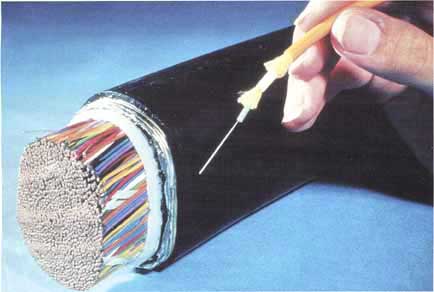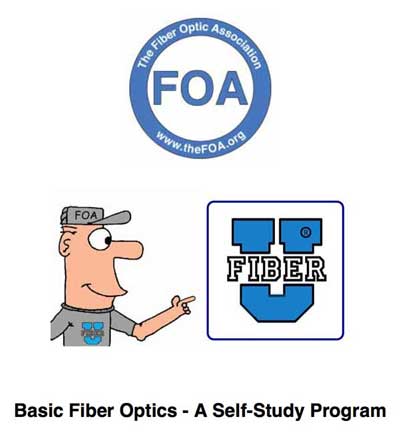Lesson
1: Introduction, Overview, Standards, Safety

AT&T
Bell Labs photo from the 1970s
Objectives: From this
lesson you should learn:
What does “fiber optics” mean
How fiber was developed and used in communications
The difference between “outside plant” and “premises”
fiber optics
Some advantages of fiber optics
What standards cover fiber optics
How to work with fiber safely
Introduction
That Bell Labs photo from the infancy of fiber optics was
used to illustrate that one tiny optical fiber could carry
more communications signals than a giant copper cable.
Today one singlemode fiber could carry the same amount of
communications as 1000 of those old copper cables! Fiber
offers thousands of times more bandwidth than copper
cables and can go more than 1000 times further before
needing repeaters - both of which contribute to the
immense economic advantage of fiber optics over copper.
You can do a similar analysis for using wireless
transmission also, but wireless is limited by the
available wireless spectrum which is overcrowded because
of everyone's desire to use more mobile devices. Fiber's
advantages has led to its use as the backbone of all of
today's communications, telecom, Internet, CATV, etc. -
even wireless where towers are connected on fiber and
antennas are using fiber up the towers too.
What is “Fiber Optics”?
Fiber optics refers to the technology of transmitting
light down thin strands of highly transparent optical
fibers, usually glass but sometimes plastic. Fiber optics
is used in communications, lighting, medicine, optical
inspections and to make sensors. The FOA is primarily
interested in communications fiber optics, so this lesson
will focus on that aspect of its application. In addition,
you will be introduced to international standards for
fiber optic components and systems. And finally, we want
to start making you aware of the safety aspects of dealing
with fiber optics because it is extremely important to
understand what it takes to work safely with fiber.
This lesson has two primary aims, to familiarize you with
the applications of fiber optics and a bit of its history
and to make you aware of the safety aspects (including
some of the most famous myths of fiber optics.)
Student Assignment:
Watch the videos and/or read the references and take the
quiz.
YouTube Videos
FOA
Lecture 1: Fiber Optics & Communications
FOA
Lecture 2: Safety When Working With Fiber Optics
Online FOA Reference:
Basic
overview
Fiber
Optic Standards
Fiber
Optic Safety
Book Chapter:
FOA
Reference Guide to Fiber Optics, Chapter 1
(Print Version)
Test Your Knowledge:
Optional - Extra Credit Reading
- Next: Lesson
2: Fiber Optic Jargon - The Language of Fiber
Optics
Return
to Lesson Plan
|

